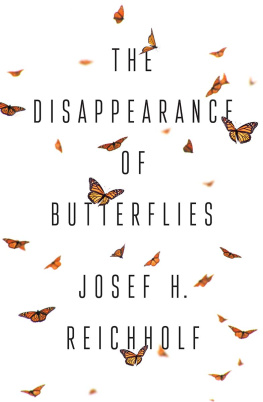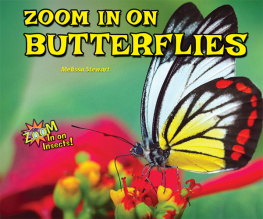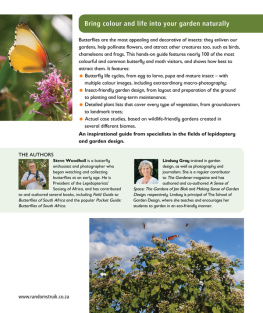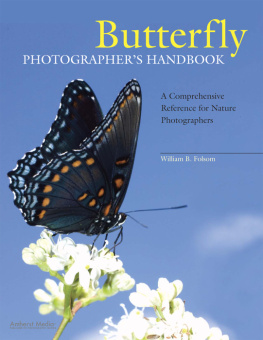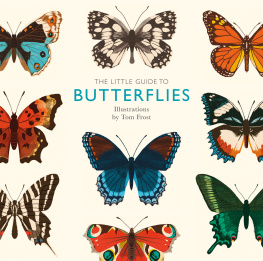
The Disappearance of Butterflies
Josef H. Reichholf
Translated by Gwen Clayton
polity
Originally published in German as Schmetterlinge: Warum sie verschwinden and was das fr uns bedeutet by Joseh H. Reichholf 2018 Carl Hanser Verlag GmbH & Co. KG, Mnchen
This English edition 2021 by Polity Press
The translation of this work was funded by Geisteswissenschaften International Translation Funding for Work in the Humanities and Social Sciences from Germany, a joint initiative of the Fritz Thyssen Foundation, the German Federal Foreign Office, the collecting society VG WORT and the Brsenverein des Deutschen Buchhandels (German Publishers & Booksellers Association).
Excerpt from Vergngliche Spuren by Miki Sakamoto reproduced with permission of Verlag Kessel. Verlag Kessel, Remagen 2014. All rights reserved by and controlled through Verlag Kessel. www.forestrybooks.com
Excerpt from Blauer Schmetterling, from: Hermann Hesse, Smtliche Werke in 20 Bnden. Herausgegeben von Volker Michels. Band 10: Die Gedichte Suhrkamp Verlag Frankfurt am Main 2002. All rights reserved by and controlled through Suhrkamp Verlag Berlin.
Polity Press
65 Bridge Street
Cambridge CB2 1UR, UK
Polity Press
101 Station Landing
Suite 300
Medford, MA 02155, USA
All rights reserved. Except for the quotation of short passages for the purpose of criticism and review, no part of this publication may be reproduced, stored in a retrieval system or transmitted, in any form or by any means, electronic, mechanical, photocopying, recording or otherwise, without the prior permission of the publisher.
ISBN-13: 978-1-5095-3981-9
A catalogue record for this book is available from the British Library.
Library of Congress Cataloging-in-Publication Data
Names: Reichholf, Josef, author.
Title: The disappearance of butterflies / Josef H. Reichholf ; translated by Gwen Clayton. Other titles: Schmetterlinge. English
Description: Cambridge, UK ; Medford, MA : Polity Press, [2020] | Originally published in German as Schmetterlinge : Warum sie verschwinden and was das fur uns bedeutet by Joseh H. Reichholf 2018 Carl Hanser Verlag GmbH & Co. KG, Munchen. | Includes bibliographical references and index. | Description based on print version record and CIP data provided by publisher; resource not viewed.
Identifiers: LCCN 2020012872 (print) | LCCN 2020012873 (ebook) | ISBN 9781509539819 (epub) | ISBN 9781509539796 (hardback) | ISBN 9781509539796q(hardback) | ISBN 9781509539819q(epub)
Subjects: LCSH: Butterflies. | Butterflies--Ecology. | Butterflies--Conservation.
Classification: LCC QL543 (ebook) | LCC QL543 .R4513 2020 (print) | DDC 595.78/9--dc23 LC record available at https://lccn.loc.gov/2020012872 LC record available at https://lccn.loc.gov/2020012873
The publisher has used its best endeavours to ensure that the URLs for external websites referred to in this book are correct and active at the time of going to press. However, the publisher has no responsibility for the websites and can make no guarantee that a site will remain live or that the content is or will remain appropriate.
Every effort has been made to trace all copyright holders, but if any have been overlooked the publisher will be pleased to include any necessary credits in any subsequent reprint or edition.
For further information on Polity, visit our website: politybooks.com
Printed endpapers: nelsonarts/iStock
Foreword
Most people in the British Isles and North America as well as on the European mainland are by now well aware that many species of wildlife are declining and even disappearing. Butterflies and moths (Lepidoptera) are prominent among them. The author of this authoritative book, Dr Josef Reichholf, became concerned about the decline of many species in his native Germany during his doctoral and postdoctoral research at the Ludwig-Maximilian University of Munich on moths in both rural and urban areas around that city in the 1970s and 1980s. He became aware of the staggering speed of change and its extent, mainly due to the intensification of agriculture. The subject of his doctoral research was a group of aquatic moths belonging to the Crambid family, which he studied intensively in the field at a cluster of gravel pits near his boyhood home in Bavaria. Some time after completing his thesis, Dr Reichholf was saddened to find that some of these pits had been converted to swimming pools and others infilled and returned to agriculture, mostly for the cultivation of maize. At the same time, the riparian woodlands along the River Inn, which had been a favourite wildlife haunt of his he started out as a bird-watcher in 1958 were being uprooted to make way for the booming and profitable cultivation of maize. With the maize monoculture came the intensive use of pesticides to control the pests that infect it.
Dr Reichholf eventually made a long-term study of the Lepidoptera in urban and suburban Munich, mainly by employing light traps, and he came to the conclusion that, although the species diversity is less in urban areas, they are doing much better in the nature-friendly cities than they are in the inhospitable countryside, because the former are islands of warmth (the heat island effect) and there is a much lower use of pesticides there. He devotes the second half of the book to a critical examination of the causes of the declines in so many butterfly and moth species: these, mostly familiar to British and North American nature conservationists, include the replacement of old, traditional farming by intensive agriculture, overuse of fertilizers and pesticides poisoning the soil, deforestation and reforestation with monocultures, habitat loss, over-tidiness, light pollution and the underlying effects of climate change.
Dr Reichholf holds strong views and is outspoken in his criticism of the role of politicians and government policies with regard to the environment and its wildlife. Some nature conservationists also come in for criticism for concentrating on legally protecting species from field naturalists and collectors and for not fully recognizing that their real enemy is industrialized agriculture. Finally, he considers the consequences of the disappearance of butterflies and moths and what can be done to arrest it.
This passionate, powerful and thought-provoking book could not be more timely. It deserves to be widely read by everyone concerned about the natural environment and I am very pleased to be able to recommend it.
John F. Burton, FZS, FRES
A Vice-President of Butterfly Conservation
Acknowledgements
I owe thanks to many people too many to be able to list them all by name. The two main forces that led to the creation of this book came from my wife and my closest friends, on the one hand, and my publisher and agent, on the other. Working together with my literary agent Dr Martin Brinkmann and my editor Christian Koth of C. Hanser Verlag was both enjoyable and stimulating. The results make me feel optimistic, despite having experienced the decline of moths and butterflies over the last 50 years, that there is at least a glimmer of hope. If such a leading German publishing house can dedicate itself so closely to the subject of the disappearance of moths and butterflies, one must believe that there are still opportunities. I am very grateful to C. Hanser Verlag for conveying such optimism.
I thank my doctoral supervisor, the late Dr Wolfgang Engelhardt, for proposing the topic of aquatic moths and the extensive engagement in nature conservation that this led to, at a time when he himself was president of the Deutscher Naturschutzring. Through his suggestion, he effectively set the course of my professional life as a zoologist. Of central importance also was the Bavarian State Collection of Zoology (ZSM): a unique institution, where, as a member, one could feel butterflies in ones stomach, while above, on the roof, real blue butterflies blithely flew around. It is beyond my abilities to try to put into words my gratitude for my time spent at the ZSM and my time as a teacher at both of the Munich universities, even though my essential attitude to life was formed professionally by these experiences. I am grateful to my wife, Miki Sakamoto-Reichholf, for the fact that I was able to combine them so well with my private life. She shares my enthusiasm for moths and butterflies.
Next page
